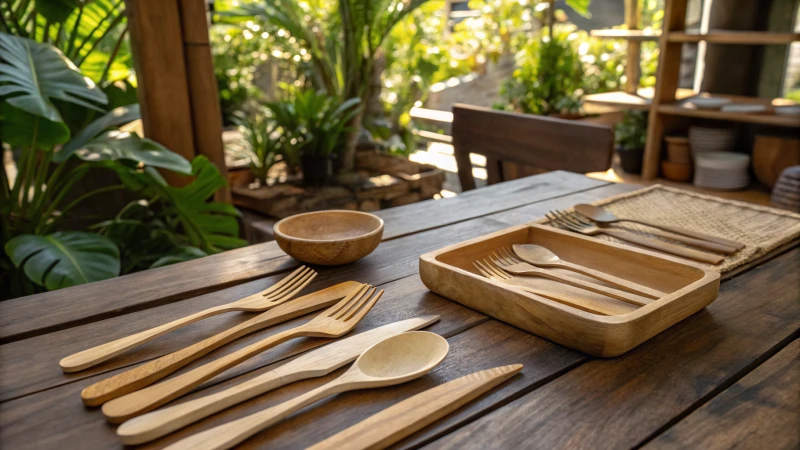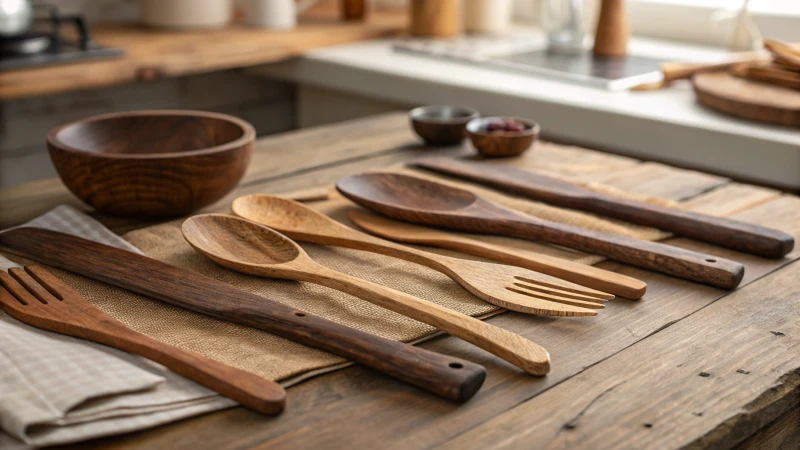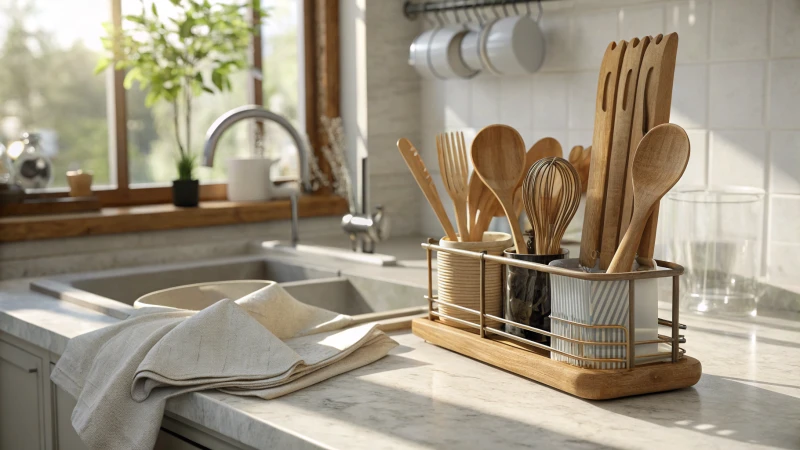
I've always been drawn to the simplicity of wooden cutlery, but I started wondering about its safety.
Disposable wooden cutlery can indeed harbor bacteria because it absorbs moisture, making additional treatments like antimicrobial coatings or proper drying essential to ensure safe use.
I remember the first time I used wooden utensils at a picnic; their rustic charm was unbeatable. But later, it got me thinking about their safety. While they decompose naturally, keeping them free from bacteria requires a bit more care. Understanding the right treatments can make all the difference in keeping your meals safe and enjoyable.
Disposable wooden cutlery absorbs moisture easily.True
Wood is porous and naturally absorbs moisture, increasing bacterial risk.
Antimicrobial coatings are unnecessary for wooden cutlery.False
Coatings reduce bacterial growth, enhancing safety and hygiene.
Why Does Wooden Cutlery Tend to Harbor Bacteria?
Remember when you first tried using wooden cutlery, enchanted by its rustic charm and eco-friendly promise? But then came the nagging thought about bacteria. How do we keep it safe and clean?
Wooden cutlery is prone to bacterial growth because it naturally absorbs moisture, creating a humid environment where bacteria can thrive. To mitigate this risk, regular drying and applying protective coatings are essential for safer use.

Why Does Moisture Matter?
I remember my first picnic with wooden cutlery—such a perfect touch of nature until I learned about how wood soaks up moisture. It's like wood has this insatiable thirst, drawing in water that creates an ideal playground for bacteria. Unlike plastic utensils1, which repel moisture thanks to their non-porous surface, wooden ones require a bit more love and care to keep them hygienic.
The Role of Hygienic Treatments
My friend once shared a tip that has stuck with me: applying a thin layer of food-grade mineral oil2. It acts like an invisible shield, helping prevent water from seeping in too deep. After washing, I always make sure to dry my wooden utensils thoroughly—it's become a sort of ritual that ensures they stay in great shape.
Comparing Material Properties
| Material | Porosity | Moisture Absorption | Bacterial Growth Potential |
|---|---|---|---|
| Wood | High | High | High |
| Plastic | Low | Low | Low |
This table says it all—wood's high porosity means it's more likely to absorb moisture compared to plastic alternatives.
Best Practices for Maintenance
- Dry Thoroughly: After washing, I always make sure to dry my wooden cutlery completely. Letting them air dry on a rack is a simple yet effective way to prevent moisture build-up.
- Use Protective Coatings: Regularly applying oils or waxes has become part of my routine to maintain that protective barrier against water.
- Proper Storage: Storing them in a dry place, away from any damp spots, ensures they remain in tip-top condition.
By understanding these factors and incorporating them into your routine, you can maintain the integrity and safety of wooden cutlery. For more insights on preventing bacterial growth3 on wooden surfaces, diving into additional research on hygiene practices can be quite enlightening.
Wooden cutlery absorbs moisture easily.True
Wood is porous, allowing it to absorb water, promoting bacterial growth.
Plastic utensils have high porosity.False
Plastic is non-porous, reducing moisture absorption and bacterial risks.
How Do Antimicrobial Coatings Work on Wooden Utensils?
Ever wondered how wooden utensils can stay hygienic without losing their rustic charm?
Antimicrobial coatings on wooden utensils incorporate agents like silver ions or organic acids, which actively prevent microbial growth by disrupting bacterial activity, thus enhancing hygiene and extending the utensil's lifespan.

The Science Behind Antimicrobial Coatings
I remember the first time I discovered the magic of antimicrobial coatings. It was during a cozy weekend kitchen experiment, trying out new recipes with my trusted wooden spoon, a gift from my grandmother. Its familiar feel in my hand got me curious about how it stayed so clean after years of use. Turns out, these coatings use agents like silver ions4, which are quite the warriors! They release charged particles that go head-to-head with bacteria, essentially zapping them away. Organic acids add to this defense by making the environment too hostile for microbes to thrive.
Application Techniques for Wooden Utensils
Applying these coatings isn’t just a matter of slapping some substance on. It's a careful dance of science and art. Methods like dipping, spraying, or even infusing during manufacturing can determine how long your favorite wooden fork stays in the game. Whether you're in mass production mode or crafting bespoke items, the technique has to fit your needs. Personally, I’ve always marveled at how even a simple spray can give my utensils an extra layer of protection while maintaining their natural beauty.
| Method | Description | Best For |
|---|---|---|
| Dipping | Submerging utensils in antimicrobial solution | High-volume production |
| Spraying | Evenly distributing the coating via spray | Custom or small-batch items |
| Impregnation | Infusing wood during manufacturing | Long-lasting application |
Factors Influencing Effectiveness
Choosing the right wood is as crucial as selecting the coating itself. During one of my projects sourcing materials for a sustainable kitchen range, I learned that bamboo, with its innate antimicrobial properties, pairs exceptionally well with these coatings. Factors like wood type and grain density significantly impact the coating's effectiveness. Exploring bamboo's natural traits5 opened my eyes to how nature and technology can work hand-in-hand to create products that are not only safe but also stand the test of time.
Understanding these dynamics helps us—whether we're buyers or manufacturers—make informed choices that meet hygiene standards and consumer expectations. Embracing this technology allows kitchens around the world to step up their game in safety and reduce cross-contamination6, making culinary adventures all the more delightful.
Silver ions in coatings kill bacteria on utensils.True
Silver ions release charged particles that disrupt bacterial cells.
Spraying is best for high-volume production of utensils.False
Dipping is preferred for high-volume production, not spraying.
How Can Proper Drying Processes Ensure Hygienic Wooden Cutlery?
Ever wondered if your beloved wooden cutlery can truly stay clean and safe?
To keep wooden cutlery hygienic, dry it immediately after washing by wiping with a dry cloth, ensuring good air circulation, and preventing moisture retention. These steps effectively reduce bacterial and mold growth, maintaining the cleanliness of your utensils.

Understanding Moisture's Role in Bacterial Growth
You know how frustrating it is when your favorite wooden spoon seems to take forever to dry, right? Moisture can be a silent enemy, especially for porous surfaces like wood. I once left a wooden spatula to air dry in a dim kitchen corner, and by the time I remembered it, a slight musty smell had started to develop. This taught me the hard way that the importance of drying7 can't be overstated.
Effective Drying Techniques for Wooden Cutlery
Let me share some tricks that I've found to keep my wooden cutlery in top shape:
- Immediate Drying: As soon as you're done washing, grab a clean, dry cloth and pat your cutlery dry. Trust me, this simple act helps prevent water from seeping into the wood.
- Air Circulation: Find a well-ventilated spot to lay your utensils out. Think about that breezy windowsill or a rack on the counter—it's perfect for letting nature do its thing.
- Towel Dabbing: I've learned the hard way that vigorous rubbing can damage the wood. A gentle dab with a towel is all it needs.
Table: Comparison of Drying Methods
| Drying Method | Advantages | Disadvantages |
|---|---|---|
| Air Drying | Natural, energy-efficient | Slower process |
| Towel Drying | Quick moisture removal | Requires constant attention |
| Heat Drying | Fast and thorough | Risk of warping or cracking |
The Role of Hygienic Coatings
I've started looking into natural coatings for my wooden utensils. They can seal the surface of the wood, keeping it from soaking up too much moisture. Always opt for food-safe and biodegradable options.
Importance of Regular Maintenance
Every so often, I like to give my cutlery some extra TLC by applying a food-safe oil. It keeps them resilient against moisture and extends their lifespan.
Ensuring Sustainability and Safety
For me, it goes beyond just drying. I make sure that my wooden cutlery comes from reputable sources8 that care for the environment as much as I do. Companies like WonBon are at the forefront of this movement.
With these drying techniques and maintenance tips, enjoying the perks of wooden cutlery without compromising on hygiene or sustainability becomes a breeze.
Immediate drying prevents bacterial growth on wooden cutlery.True
Immediate drying removes moisture, reducing the environment for bacteria.
Heat drying is the safest method for wooden cutlery hygiene.False
Heat drying risks warping or cracking, making it less safe.
Are There Certifications for Safe and Sustainable Wooden Cutlery?
Navigating the world of wooden cutlery certifications can feel like deciphering a secret code, but it's crucial for both eco-friendliness and food safety.
Yes, certifications like FSC (Forest Stewardship Council) and FDA (Food and Drug Administration) ensure that wooden cutlery is sustainably sourced and safe for food use. These certifications help maintain ecological balance and consumer safety.

Understanding Wooden Cutlery Certifications
I remember the first time I considered switching to wooden cutlery for my business. It was a simple idea, yet the complexities of ensuring both sustainability and safety soon became apparent. Like many others, I wanted assurance that the products I was choosing would not only align with my brand’s eco-friendly image but also be safe for my customers.
Wooden cutlery is gaining popularity as a sustainable alternative to plastic. To ensure that these products meet eco-friendly and safety standards, several certifications are crucial. Let's explore some of the key certifications9 involved.
| Certification | Description | Benefits |
|---|---|---|
| FSC | Forest Stewardship Council certification ensures wood is sourced sustainably. | Promotes responsible forest management. |
| FDA | The Food and Drug Administration oversees the safety of food-related products. | Ensures materials are safe for food contact. |
| LFGB | German Food, Commodity, and Feed Act guarantees product safety in the EU. | Confirms compliance with European safety standards. |
The Importance of FSC Certification
I recall visiting a forest certified by the FSC and being amazed at the care taken to preserve biodiversity while harvesting wood responsibly. The FSC certification is globally recognized, confirming that wooden cutlery comes from responsibly managed forests. This certification helps maintain biodiversity10 and ensures that forestry practices meet high environmental and social standards.
FDA Certification for Food Safety
As someone who has worked closely with food products, I can't stress enough how crucial FDA certification is for any product intended to contact food. This ensures that wooden cutlery is free from harmful chemicals and suitable for human consumption, providing peace of mind to consumers.
LFGB Compliance in Europe
My first major event in Europe taught me just how stringent the regulations can be. The LFGB standard is particularly relevant for markets in Europe, where there are strict regulations regarding materials used in food-related products. This certification verifies that the cutlery has passed rigorous safety tests.
Additional Certifications to Consider
Beyond FSC, FDA, and LFGB, other certifications like PEFC (Programme for the Endorsement of Forest Certification) or ISO standards can also be important indicators of quality and sustainability11.
| Additional Certifications | Description |
|---|---|
| PEFC | Similar to FSC, it promotes sustainable forest management. |
| ISO Standards | International standards ensuring quality and safety in product manufacturing. |
By understanding these certifications, businesses can make informed decisions about sourcing wooden cutlery that aligns with their sustainability goals and safety requirements. With each choice, we contribute to a greener future while ensuring the safety and satisfaction of our customers.
FSC certification ensures sustainable wood sourcing.True
FSC certification verifies that wood is sourced from responsibly managed forests.
LFGB certification is mandatory in all EU countries.False
LFGB compliance is important but not mandatory in all EU countries.
Conclusion
Disposable wooden cutlery can harbor bacteria due to moisture absorption. Antimicrobial coatings and proper drying techniques are essential for maintaining hygiene and safety during use.
-
Explore how plastic utensils offer advantages such as reduced bacterial risk due to their non-porous nature. ↩
-
Learn how food-grade mineral oil creates a protective barrier on wood, reducing moisture absorption. ↩
-
Find practical tips on preventing bacterial growth on wooden surfaces through effective maintenance techniques. ↩
-
Explore how silver ions function as effective antimicrobial agents by disrupting bacterial cells. ↩
-
Learn about bamboo's inherent antibacterial traits that complement antimicrobial coatings. ↩
-
Discover how these coatings minimize the spread of bacteria in kitchen environments. ↩
-
Understand why drying is crucial for preventing bacterial growth on wooden surfaces. ↩
-
Discover how ethical sourcing ensures sustainable and safe wooden products. ↩
-
This link explores various certifications ensuring sustainable sourcing and safety of wooden cutlery. ↩
-
Learn how FSC certification supports biodiversity through responsible forest management. ↩
-
Discover the differences between PEFC and FSC certifications in promoting sustainable forestry. ↩

